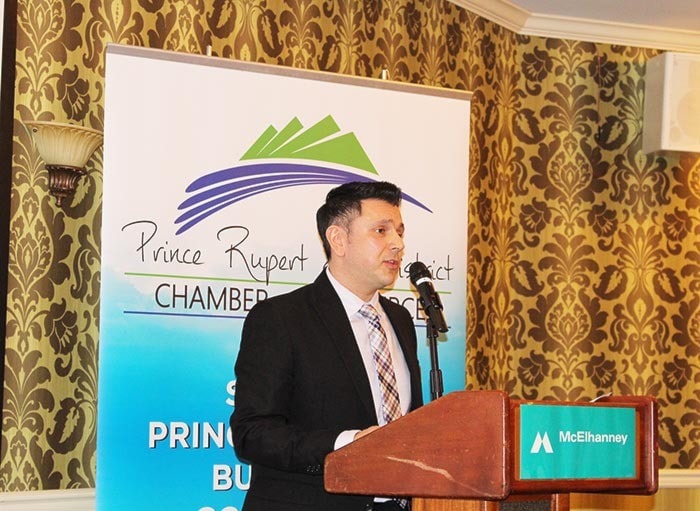No more airport prison bus.
That was one of the main takeaways from the City of Prince Rupert’s Paul Vendittelli’s Chamber of Commerce April luncheon speech and certainly the one that received the most applause from the enthused audience in attendance.
During last Wednesday’s gathering, which also hosted the Chamber’s annual general meeting (AGM), city economic development officer Paul Vendittelli provided an update on the Prince Rupert Airport (YPR) and its optimistic future.
“The old Highway coach bus and the prison bus as we all know it are officially retired,” said Vendittelli.
“So you can expect to see some new busses here [within two weeks] ... and we’re trying to get the busses moving within 20 minutes of getting off your flight.”
The new busses and the recently completed airport shuttle centre are some of the immediate changes to the airport to improve one of the most unique flyine experiences in Canada, but more is in the works for its efficiency. The end result of those ambitious plans are still up in the air.
In the midst of completing a major renovation on the terminal itself, expected to be finished by the end of the month, the airport includes brand new washrooms, new offices, a luggage conveyor belt, a passenger-holding capacity increase from 100 fliers to 200 per hour, earthquake-proofing technology and new furnace heating and cooling systems. But even more is in store for the airport on Digby Island.
Working with WSP, a global engineering firm which has overseen 600 airport projects, the city has drafted an Airport Master Plan – the first of its kind for the Prince Rupert Airport – to develop different operating scenarios for current and future operations.
Currently, the airport has a 6,000-foot runway (150-feet wide), high-intensity runway lights and can handle aircraft such as the Airbus 320 family, Boeing 737s, Bombardier Dash 8s and the Bombardier Q400s. A paved apron providing for two aircraft parking slots is completed and the building features an automated weather observation system. The airport’s capacity for the number of aircraft movements or annual service volume (ASV) for the airport stands at 220,000 and currently has 3,000 aircraft movements, well below capacity.
“The airfield can meet movement demands without diverse effects of aircraft operations and without incurred operational delays,” said Vendittelli.
The economic development officer detailed two of five expansion scenarios for the airport developed by WSP.
With each potential LNG project moving forward and with a positive FID (final investment decision), more needs to be done to make sure the airport can handle the added stresses of having numerous workers come in and out of the city.
“Scheduled traffic will increase sharply as soon as construction gets underway. Each project will require a substantial amount of corporate and supplier activity. What we see with the plan, work charters will be processed through a separate facility and not impact the passenger terminal facility and once traffic reaches 100,000 passengers [per year] it’s expected that WestJet would begin service into the area. Air Canada is ready to move for any rapid growth. They’ve added a third flight this summer and are watching what’s been going on in the area in case we get a positive FID,” Vendittelli said.
Currently, the Prince Rupert Airport handles 60,000-65,000 passengers per year.
An additional LNG processing facility is proposed to be constructed to support construction workers working in Prince Rupert on a rotational basis.
“It is proposed that this facility be accommodated within a structure that could be reused for other purposes ... like an aircraft hanger, warehousing airport garage, etc...” he said.
Another scenario would involve 25-30 years of city growth and have additional buildings, fire services, an extended runway (7,500 feet) to accommodate fully fuelled aircraft travelling to eastern Canada such as Ontario, and an airport access route with continuous ferry service and short road networks to Digby Island (a bridge crossing) and new infrastructure like drive-able access to Metlakatla and road connections to Tuck Inlet and Lax Kw’alaams.
This access project is already in the early stages by the city, which has reached out to the province acquire a Prince Rupert Area Corridor Analysis (PRACA). That report, which cost the province more than $1 million, will be officially announced at a later date by the city, said Prince Rupert Mayor Lee Brain at the lunch.
“The airport is ready for increased passenger traffic, we have a brand new building and if we get a positive FID, we will be looking at constructing new facilities to process those workers and the runway is ready. The airport itself can handle any new developments that are coming into the area,” Vendittelli said.
